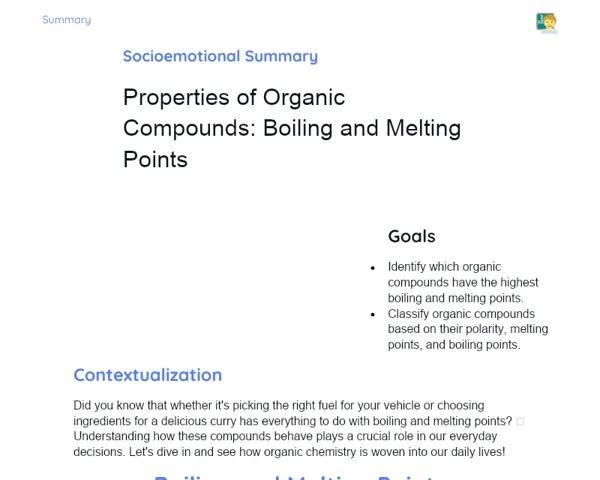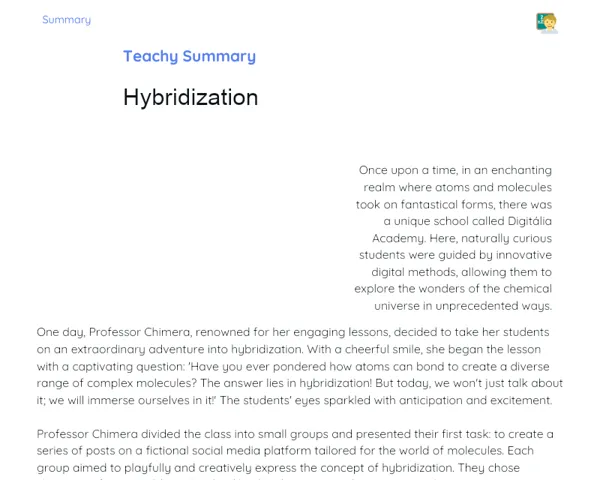Summary Tradisional | Properties of Organic Compounds: Solubility of Organic Compounds
Contextualization
Understanding the solubility of organic compounds is very important as it explains how these substances interact with a variety of solvents, impacting their use in many fields of chemistry and day-to-day life. In our laboratories and industries alike, solubility plays an important role in the making of medicines, cleaning agents, cosmetics, and even food products, where the ability of a compound to dissolve in a particular solvent can determine its effectiveness. Grasping this property helps in predicting how substances behave under different conditions and in fine-tuning both industrial and academic procedures.
In organic chemistry, the solubility is largely dictated by the polarity of molecules and how they interact with each other. Simply put, polar compounds lift well in water or similar solvents, whereas nonpolar compounds find a better match in nonpolar solvents – a concept best described by ‘like dissolves like’. Additionally, factors such as temperature, pressure, and the presence of certain functional groups can influence how well a compound dissolves, making this subject very relevant for practical applications and new technological developments.
To Remember!
Polarity and Solubility
The polarity of a molecule is a key feature that directly impacts its solubility. Polar molecules have an uneven spread of electric charges, which enables them to interact well with solvents like water. In contrast, nonpolar molecules, where the charge is evenly distributed, tend to mix better with nonpolar solvents like benzene or ether. The age-old principle of ‘like dissolves like’ helps us understand why polar solvents dissolve polar substances and nonpolar solvents dissolve nonpolar ones.
Take, for instance, organic compounds that dissolve in water; the presence of polar functional groups facilitates the formation of hydrogen bonds with water molecules. Examples include carboxylic acids and alcohols. On the other hand, hydrocarbons, being nonpolar, do not mix with water but are easily soluble in nonpolar solvents.
Moreover, the structure of the molecule matters. Molecules with long carbon chains might be less soluble in water even if they bear polar groups, due to the dominating nonpolar nature of the long chain. Hence, both polarity and molecular structure work hand in hand to determine solubility in various solvents.
-
Polar molecules mix well with polar solvents.
-
Nonpolar molecules are best dissolved by nonpolar solvents.
-
Polar functional groups, like hydroxyl and carboxyl, help a compound dissolve better in water.
Intermolecular Interactions
Intermolecular interactions are the forces operating between molecules, crucially affecting the solubility of organic compounds. Some of the common interactions include hydrogen bonds, Van der Waals forces, and dipole-dipole interactions, each influencing solubility in its own way.
In our practical sessions, you will notice that hydrogen bonds – which form when a hydrogen atom, attached to a strongly electronegative atom like oxygen or nitrogen, interacts with another electronegative atom – play a significant role, especially in compounds like alcohols and carboxylic acids. On the contrary, Van der Waals forces, though weaker, are responsible for the solubility of nonpolar compounds such as hydrocarbons in nonpolar solvents.
Additionally, dipole-dipole interactions, where positive ends of polar molecules attract the negative ends of others, are key in making polar compounds dissolve in polar solvents. Together, these interactions shape the solubility profile and are critical for both industrial applications and research experiments.
-
Hydrogen bonds enhance solubility, especially in water.
-
Van der Waals forces determine the solubility of nonpolar compounds.
-
Dipole-dipole interactions are essential for polar compounds in polar solvents.
Solubility in Water
The solubility of organic compounds in water largely depends on their capacity to interact with water molecules. Polar organic compounds like alcohols and carboxylic acids have functional groups that form hydrogen bonds with water, making them easily soluble. For example, ethanol dissolves very well in water because its hydroxyl group (-OH) can form hydrogen bonds.
On the flip side, nonpolar organic compounds, such as hydrocarbons, lack the necessary groups to interact strongly with water, making them insoluble. Hexane stands as a classic example; its long carbon chain prevents it from forming hydrogen bonds with water, resulting in its inability to dissolve.
Even the size of the molecule is a factor here. Smaller molecules with polar groups are generally more soluble in water than larger ones where the nonpolar component dominates. Thus, the interplay of polarity, molecular structure, and the potential for forming intermolecular bonds determines how well organic compounds dissolve in water.
-
Polar organic compounds are generally soluble in water.
-
Functional groups like hydroxyl and carboxyl promote hydrogen bonding with water.
-
Nonpolar compounds, such as many hydrocarbons, do not mix well with water.
Solubility in Organic Solvents
When it comes to organic solvents, the same rule of ‘like dissolves like’ applies. Nonpolar organic compounds usually dissolve in nonpolar solvents like ether or benzene because their intermolecular forces are well matched.
For example, hydrocarbons such as hexane mix well with benzene because both are nonpolar and interact through Van der Waals forces. In contrast, polar compounds like alcohols and carboxylic acids do not dissolve well in nonpolar solvents since the required interactions are missing.
Also, if a compound carries specific functional groups which can engage in dipole-dipole interactions or hydrogen bonding, it may show improved solubility in particular organic solvents. Therefore, understanding both the molecular structure and the nature of the solvent is essential in predicting solubility in organic media.
-
Nonpolar organic compounds are best dissolved by nonpolar organic solvents.
-
Hydrocarbons dissolve well in solvents like ether and benzene.
-
Presence of functional groups can modify solubility in organic solvents.
Key Terms
-
Solubility: The capability of a substance to dissolve in a solvent.
-
Polarity: The uneven distribution of electrical charges in a molecule.
-
Intermolecular Interactions: Forces between molecules that affect solubility.
-
Hydrogen Bonds: Strong bonds formed when hydrogen is attached to an electronegative atom and interacts with another.
-
Van der Waals Forces: Weaker forces acting between nonpolar molecules.
-
Dipole-Dipole Interactions: The attraction between the positive end of one polar molecule and the negative end of another.
-
Polar Solvents: Solvents like water that have an uneven charge distribution.
-
Nonpolar Solvents: Solvents such as benzene and ether with an even charge distribution.
-
Carboxylic Acids: Organic compounds containing the -COOH group.
-
Alcohols: Organic compounds featuring the -OH group.
-
Hydrocarbons: Organic compounds made up of carbon and hydrogen.
-
Temperature and Pressure: Factors that can influence how well a compound dissolves.
Important Conclusions
The solubility of organic compounds is a fundamental property that influences our work in both laboratories and industries. By understanding molecular polarity and intermolecular interactions, we can predict how different compounds will behave in various solvents, which is crucial for formulating products ranging from medicines to cleaning agents and cosmetics.
Our discussion today emphasised the role of interactions such as hydrogen bonds and dipole-dipole forces in enhancing solubility. Polar compounds, like alcohols and carboxylic acids, dissolve well in water due to these interactions, whereas nonpolar compounds, such as hydrocarbons, prefer nonpolar solvents because of Van der Waals forces.
Considering factors like temperature, pressure, and the presence of specific functional groups is vital for optimizing reactions and production processes. This understanding is not only applicable in academic research but is also very useful for practical applications in various industries. I encourage students to dive deeper into this topic as the principles of solubility form the backbone of many technological and scientific advancements.
Study Tips
-
Revise the concepts of polarity and intermolecular interactions, and see how they affect the solubility of organic compounds.
-
Work on practical examples to observe how different compounds behave in polar and nonpolar solvents.
-
Check out additional resources such as educational videos and scientific articles to enrich your understanding of solubility.



